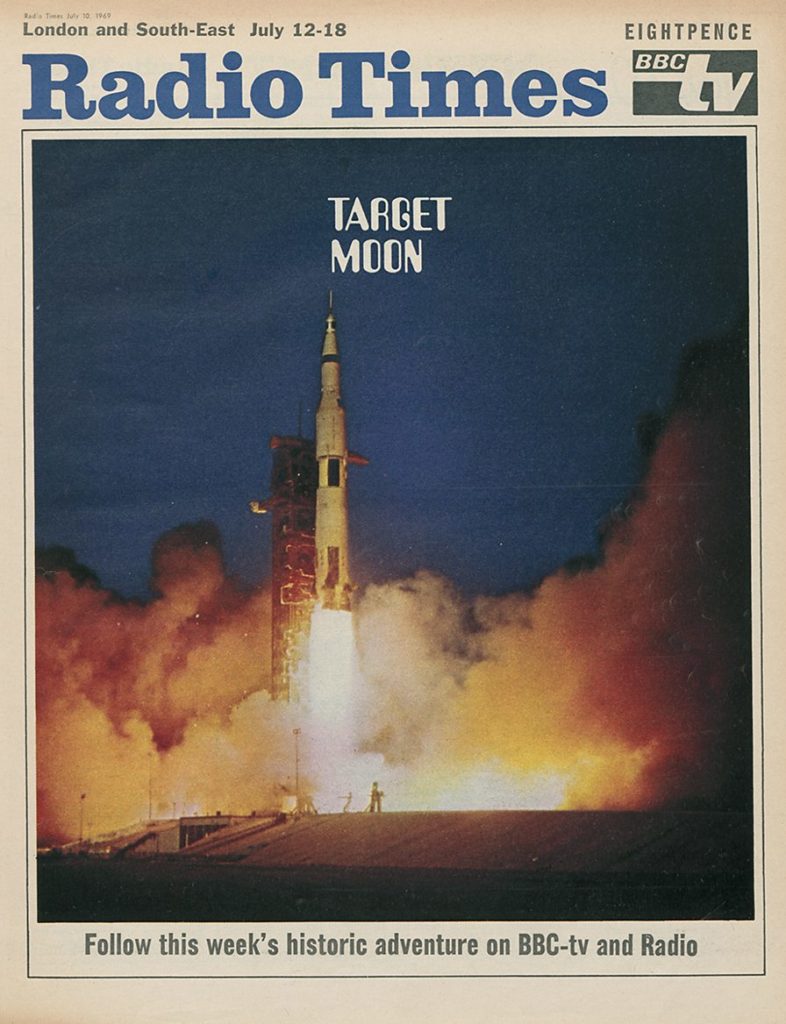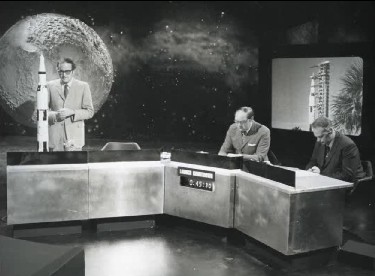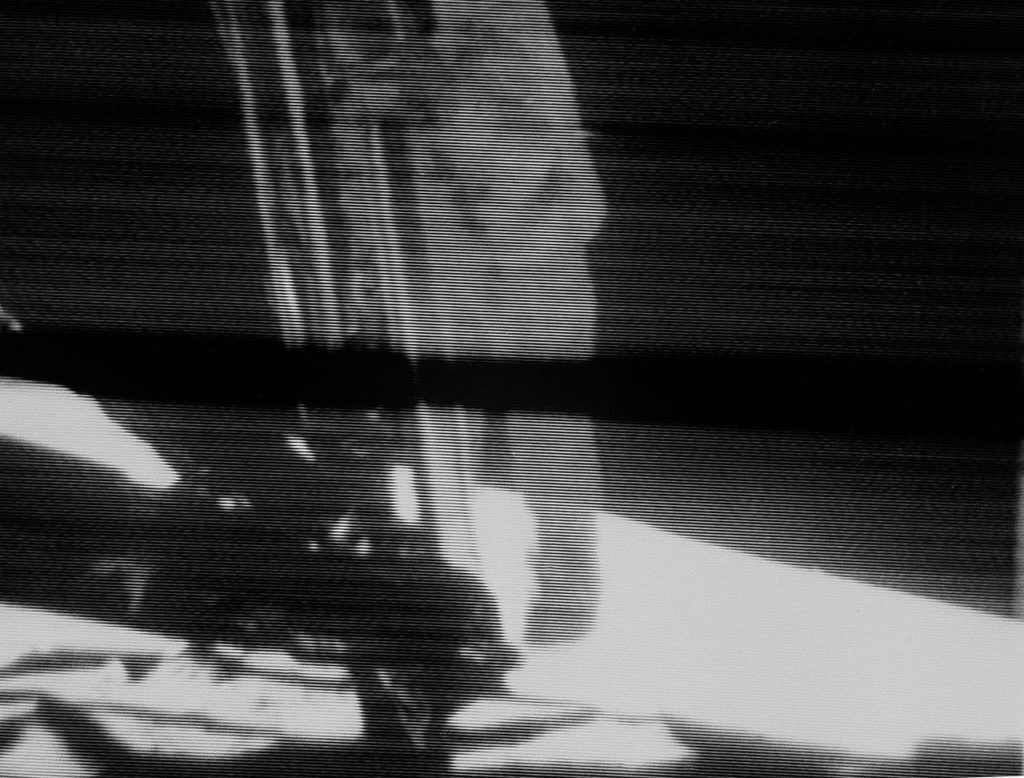The landing of Apollo 11 lunar module ‘Eagle’ on the surface of the Moon in July 1969 was one of the most significant events of the 20th century. An estimated 650 million people worldwide were glued to a television set, watching Neil Armstrong take humanity’s first steps on another celestial body. Of those 650 million, an estimated 16 million were in the UK.

Television coverage in the UK of the eight-day mission was made possible by an antenna nicknamed ‘Arthur’ at Goonhilly Earth Station in Cornwall, which was at one point the largest satellite station in the world. ‘Arthur’ intercepted signals being sent back to Earth by Apollo 11 and transmitted them to London, where the Post Office Tower (now the BT Tower) then distributed them to regional networks and television sets across the country.
UK viewers wound up having a choice of where to watch the landing: on the BBC or on ITV. Cliff Michelmore anchored the BBC’s coverage, joined by James Burke and Patrick Moore in the studio as analysts and Michael Charlton as an on-site reporter in both Mission Control in Houston and Cape Kennedy in Florida. Burke and Moore already had extensive experience in covering NASA missions, including the Apollo 8, 9 and 10 flights that had tested out all the equipment and procedures Apollo 11 would need to make the first landing. Aside from reports about the mission, the BBC’s coverage also featured poetry readings from the likes of Ian McKellan and Judi Dench, as well as an instrumental song by Pink Floyd called ‘Moonhead’ that was produced exclusively for the event.

ITV’s coverage, meanwhile, was fronted by Alastair Burnet with the help of science correspondent Peter Fairley and former NASA public affairs officer Paul Haney. ITV’s coverage was more light-hearted than the BBC’s, with an entertainment show called ‘David Frost’s Moon Party’ broadcast inbetween bulletins with guests like Cliff Richard, Cilla Black and Engelbert Humperdinck.
Apollo 11 lifted off from Cape Kennedy on 16 July 1969 with Neil Armstrong, Buzz Aldrin and Michael Collins onboard. The mission helped highlight a humorous contrast in how quickly different kinds of technology were developing. On one hand, humans were on their way to land on the Moon for the first time. But on the other, neither BBC One nor ITV could broadcast in colour until four months after Apollo 11. Not that it would have made much difference to those tuning in—Apollo 11’s video camera also only recorded in black and white.
The landing came three days into the mission, late in the evening on 20 July 1969 at 21:17 BST. Armstrong and Aldrin’s emergence out onto the surface wasn’t until six and a half hours later. In the initial mission plans this gap was supposed to be even longer, with Armstrong and Aldrin getting five hours of sleep before going out onto the Moon’s surface. Armstrong and Aldrin, however, decided to forego their rest period, saying they felt they would be unable to sleep.

Armstrong’s first steps on the Moon came at 03:45 BST on 21 July 1969. According to John Godson, who was BBC Gallery Director at the time: “When Neil Armstrong stepped onto the Moon’s surface, the whole BBC control room with the canteen ladies and security guards standing beside the vision control desk, exploded into cheering and clapping.”

In the studio, Michelmore, Burke and Moore were all careful not to accidentally talk over anything Armstrong said, especially in those first few moments. When things settled down, they answered questions from the public and used models of the Moon, Earth and Apollo 11 spacecraft to help detail what was happening, as they had and would continue to do throughout the rest of the mission.
In all, the BBC made 27 hours of broadcasts compared to ITV’s 16. Notably, both BBC One and ITV stayed on air continuously for 11 hours between 23:30 on 20 July and 10:30 on 21 July, making the UK’s first all-night television broadcasts.
Anyone wanting to watch the BBC and ITV’s coverage back, however, will be disappointed. It was routine in the 1960s for recordings of footage to be wiped and as a result, only fragments of the broadcasts still exist today.
Fantastic piece of history remember staying up late to watch it on our black n white television about 18” screen
There was a special Apollo 11 bbc 1 program to watch liftoff from the lunar surface which has never been shown in the 21sr century. Can we view again?
I can remember my Mother and Father waking my older brother, my younger brother and myself to witness the moon landing on TV in the middle of the night, which would almost certainly have been the BBC coverage.
I was seven years old and soon on the 28th of September to be eight.
An absolute privilege to be able to watch it all unfold on our small black and white set in our first house.
To quote the article:
“‘Arthur’ intercepted signals being sent back to Earth by Apollo 11 and transmitted them to London, where the Post Office Tower (now the BT Tower) then distributed them to regional networks and television sets across the country.”
This would have been impossible without conversion of the signal somewhere along the way and the only ground stations equipped with the RCA scan converters were in California and Australia. Could the author please elaborate or, better still, provide references to these claims?
I used to work at BBC TV Centre and one job I had was to check all the BBC recordings of Apollo 11. Sadly there were very few of them, I’d guess, many decades later, less than 20. My name is on all the recording report cards now !